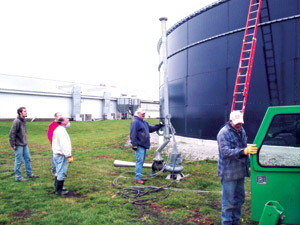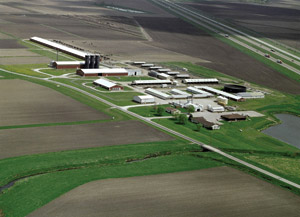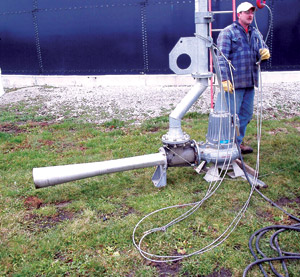
Features
Applications
Swine
ISU Farm defeats swine odor through aeration
October 9, 2008 by Manure Manager
The large-scale hog farms of today
have brought a proportionate increase in environmental issues for this
multi-billion dollar segment of the agricultural economy.

As an informal odor control experiment, ISU Farm management and researchers added a submersible aeration system to the slurry separation process chain.
|
The large-scale hog farms of today have brought a proportionate increase in environmental issues for this multi-billion dollar segment of the agricultural economy. With some swine operations having hundreds, even thousands, of confined animals in various stages before market, their waste management has become a catalyst for controversy and led some regulators to limit or cease issuing permits for construction of new or expanded hog farms. Some experts even foresee the U.S. Environmental Protection Agency adopting additional regulations affecting established manure management practices.
Researchers at the 610-acre Illinois State University (ISU) Farm near Lexington, Illinois, have been addressing the issue of manure and odor management with a number of demonstration initiatives at the facility’s 200-sow farrow-to-finish unit. The program has focused on polymer-assisted separation of manure solids from the much larger percentage of liquid in manure. Other elements include producing marketable compost from the separated manure solids and using the separated effluent for land application at controlled rates and nutrient compositions on a cornfield.
Most recently, the ISU Farm has been experimenting with odor control of the separated effluent in light of complaints from neighboring property owners about objectionable smells.
The operation’s existing manure management program involves a solid-liquid separation system utilizing a polyacylamide flocculent in conjunction with passing the raw slurry through a belt thickener and gravity screen separator. The two-step separation results in removal of up to 98 percent of the solids.

Researchers at the 610-acre Illinois State University (ISU) Farm have been addressing manure and odor management issues with a number of demonstration initiatives at the facility’s 200-sow farrow-to-finish unit.
|
Over the past two years, swine on the farm have produced two million gallons of raw slurry, resulting in 1.8 million gallons of effluent and 200,000 gallons of solids. While the liquid is stored in an above ground storage tank before being used for weekly gutter flushing or applied as irrigation water to crops, the separated solids are condensed into 10 to 12 percent dry matter and combined with landscape waste to produce 200 to 400 tons of marketable compost (see sidebar).
As an informal odor control experiment, ISU Farm management and researchers recently added a submersible aeration system to the slurry separation process chain. A single nozzle aerator, driven by a 10-horsepower Flygt submersible N-pump, was installed in the farm’s 900,000-gallon Slurrystore to help convert the anaerobic process within the tank into an aerobic environment. A Flygt specialist in agriculture arranged for loan of the system.
“A submersible aerator works much better than a surface mixer, which only stirs the liquid and pulls some oxygen off the top but not in significant enough amounts to create the desired aerobic results,” explains Ron Skinner, agricultural market manager for Flygt. “The aeration system used at the farm employs a Venturi effect ejector that pulls air deep into the tank to more fully oxygenate it. That reduces the odor along with the amount of nitrogen as a result of the transfer.”

A single nozzle aerator, driven by a 10-horsepower Flygt submersible N-pump, was installed in the farm’s 900,000-gallon Slurrystore to help convert the anaerobic process within the tank into an aerobic environment.
|
According to farm management, the additional aeration almost immediately improved the separated liquid, which always retained a certain degree of objectionable odor during prior irrigation use despite being a nearly clear fluid following the separation process.
“Although we didn’t conduct a really scientific trial of the aerated liquid, the addition of aeration within the storage tank delivered an immediate odor reduction in the separated liquid,” said Dr. Paul Walker, a professor of animal science at ISU. “The field hands noticed it when working on the irrigation system and, equally important, so did the neighboring farmer.
“It clearly passed the sniff test,” Dr. Walker concluded.
A 40-acre cornfield – with 180/bushel yield as the production goal – received the aerated effluent through a center pivot and newly installed underground irrigation system.
Dr. Walker anticipates that public opposition to hog farm odor emissions will result in the U.S. Environmental Protection Agency (EPA) encouraging — through regulation — changes in the customary storage and land application practices. It’s hoped that research conducted at the ISU Farm, including the informal aeration demonstration, can help benefit manure management programs at both large and small swine operations.
“The aeration experiment was less scientific than a practical attempt to overcome the significant odor off the center pivot that was reaching a downwind neighboring farm,” said Russ Derango, ISU Farm manager. “We tried to show here that a swine operation can be a good neighbor.”
| ISU Farm research The Illinois State University Farm’s program strives to objectively analyze combined solid/liquid separation in tandem with solids composting to control odor and phosphorous contamination as well as to develop instruction materials and to host field days to demonstrate manure management practices for farmers, academics, consultants and government agency educators. Composting “In addition to keeping the odor down in the solids, we produce a value-added product that can supplement farm income,” he added. The cost for composting the manure solids has ranged from $10 to $20 per ton of finished compost. As a comparison, the farm can separate processed liquid manure for less than one cent a gallon. Crop research Past farm research has shown that applying enough raw slurry to cornfields to achieve yields of 180 bushels/acre reflects a 95-pound over-application of phosphorous. By separating the liquid and solid fractions of the manure and applying the effluent alone, researchers have shown that phosphorous is reduced to a 32-pound acre deficient, making it a non-issue. The N:P ratio shifts from 4:1 for unprocessed raw slurry to a range between 15 to 20:1 in separated effluent. The corn plant requires a 15 to 16:1 N:P ratio. Dr. Paul Walker, a professor of animal science at ISU, says the ISU Farm can separate processed liquid manure for less than one cent per gallon and the liquid is so clean that clogging does not occur along the center pivot system. |